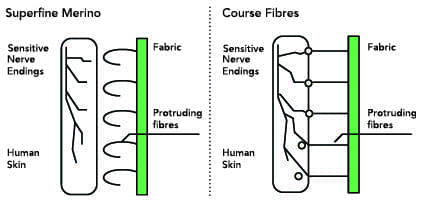Skin is the human body’s largest organ and interacts with the external environment 24 hours every day. Next-to-skin clothing play a very important role in health and hygiene, and wool has many properties that make it an excellent option. In particular, superfine Merino wool can have a very beneficial impact on skin health, comfort and general quality of life.
 Wool’s excellent moisture vapour absorbency enables it to maintain a much more stable temperature and humidity between the skin and the garment, compared to other fabric types. Not only do woollen garments perform well during many activities, but they also improve comfort during all stages of sleep.
Wool’s excellent moisture vapour absorbency enables it to maintain a much more stable temperature and humidity between the skin and the garment, compared to other fabric types. Not only do woollen garments perform well during many activities, but they also improve comfort during all stages of sleep.
Merino wool garments are the most breathable of the common apparel types because of wool’s ability to absorb and release twice as much moisture vapour as cotton, and 30 times as much as polyester.
Choosing the right type of wool
Some believe that wearing wool next to the skin can causes a prickly sensation. In truth, this applies to all fabric fibres, if they are thick enough. There is no need to be afraid of wearing wool – there are many garments made out of finer wool that are ideal for wearing next to the skin at any time, and can actually be beneficial for people who suffer from eczema or dermatitis (more on this below).
The allergy myth
Wool is made of keratin, the same protein in human and other animal hair. It is very rare to be allergic to the material itself (which would mean being allergic to your own hair). Allergies – e.g. to cats and dogs – are usually to the dander and saliva of the animals.
How wool benefits eczema patients
Recently published research has demonstrated that wearing superfine Merino wool next to the skin is beneficial for eczema sufferers. This adds to a growing number of research findings supporting the wellbeing benefits of superfine Merino wool.
The research has shown that wearing superfine Merino wool significantly improves the severity and symptoms of this chronic skin condition, challenging misconceptions that all wool is prickly and itchy.
Eczema, also known as Atopic Dermatitis (AD), now affects up to 28% of children. Its prevalence varies geographically and is increasing in many countries. Eczema sufferers have dysfunctional skin that dries out, which can lead to cracked skin, bacterial infection, redness, scratching and itching.
 When worn next to the skin, super fine Merino wool works as a dynamic buffer, helping to stabilise the humidity levels and temperature of the micro-climate between the fabric and the skin. It appears super fine Merino wool acts like a second skin for people whose ‘first’ skin is too dry.
When worn next to the skin, super fine Merino wool works as a dynamic buffer, helping to stabilise the humidity levels and temperature of the micro-climate between the fabric and the skin. It appears super fine Merino wool acts like a second skin for people whose ‘first’ skin is too dry.
Three dermatology trials, all published in leading journals, have shown that infant, adolescent and adult eczema sufferers have reported reduced symptoms when wearing superfine Merino wool garments next to the skin. In these studies, participants benefitted from wearing superfine Merino wool garments with a mean fibre diameter ≤17.5 mm for at least 6 hours/day for 6 weeks on the severity and symptoms of Atopic Dermatitis.
Find the research on our Wool Science page in the section on Health & Wellness.

